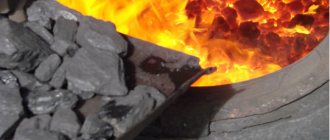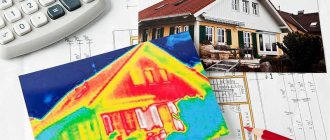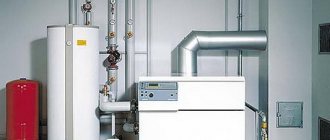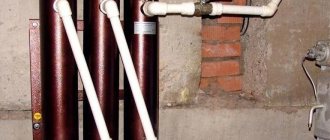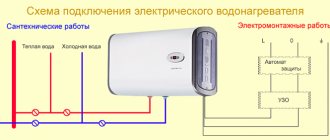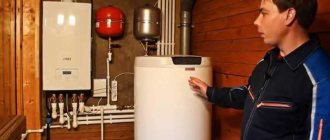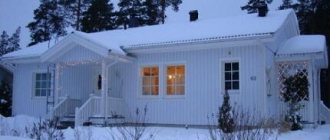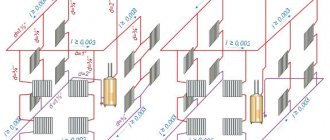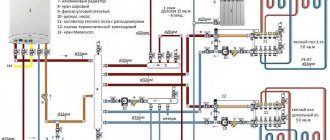Before we look at our rating of the best solid fuel boilers of 2021, I would like to answer a number of important questions that will help many novice users decide on a purchase. First, you need to decide what to choose: a single-circuit boiler paired with a boiler or column, or a double-circuit analogue, equipped with an additional heat exchanger for organizing hot water supply. Due to the fact that our list contains an overwhelming number of affordable and budget-friendly models, we focused on single-circuit solutions (mainly) for several reasons: they are cheaper; in the event of a breakdown, the entire house will not be left without heat; the boiler and boiler provide quick access to heat and hot water. On the other hand, dual-circuit models provide space saving, as they combine two types of equipment.
In turn, according to the principle of operation, all solid fuel solutions for the home can be divided into several categories:
- Pyrolysis - in such equipment the fuel smolders and does not burn, as is the case with analogues, as a result of which only gases are released, which, in turn, are saturated with heat. It is important that the firewood and processed products have high humidity for pyrolysis;
- Classical - in such systems, heat is released during the flaming combustion of solid materials, and to maintain the temperature it is necessary to regularly replenish reserves with coal, firewood and processing waste, including stumps;
- Long burning - in such devices heat is generated slowly, which is due to the name of the equipment. The main advantage is the burning time of firewood, up to several days.
Rating of solid fuel boilers
Manufacturers take into account customer requirements for modern technology. In addition to classic designs, the companies' catalogs now include long-burning solid fuel boilers, capable of operating for up to 36 hours on one load of coal. Pyrolysis boilers demonstrate excellent characteristics. We have studied the features and specific operation of equipment of all categories on the market. To be included in the rating, equipment had to meet strict safety requirements, have high efficiency, be functional and easy to maintain. Our team took into account user feedback, compared fuel consumption, and analyzed maintainability.
Experts paid special attention to the following characteristics:
- Recommended fuel – the combustion temperatures of wood and coal are different, this affects the choice of material for the chamber;
- Power – affects the frequency of bookmarks;
- Efficiency - the profitability of the heating system depends on this indicator;
- Volatility - automatic models are easy to use, but require increased attention to ensuring uninterrupted power supply;
- Safety – the use of thermal insulation reduces the risk of burns and ignition of building materials;
- Durability – the quality of steel and cast iron affects the service life.
Not all models met the stated characteristics and requirements of experts. Equipment with a low level of safety, high fuel consumption, and low-quality main components were excluded from our rating.
The best wood splitters
Operating rules
For efficient heating operation, it is important to choose the right fuel, taking into account its density, humidity, fraction, and adhere to recommendations for storing materials. It is necessary to regularly maintain the equipment, monitor its operation, and comply with the requirements for the coolant (its hardness coefficient, chemical composition).
Preventing overheating
Exceeding the permissible heating temperature of the coolant and the boiler unit for a long time reduces the operating life of the boiler installation and increases the likelihood of an emergency. Parameter control is needed to create comfortable conditions in the house and optimize fuel consumption. Overheating is prevented by installing safety valves, using an additional built-in heat exchanger or an emergency circuit.
Exceeding the heating temperature reduces the operating life of the boiler installation.
Exhaust gas outlet
Compliance with smoke removal rules is the main requirement for safe operation of the boiler. To do this, choose a round pipe with a smooth inner surface made of stainless steel or asbestos.
Its diameter and height are determined by the power of the unit; thermal insulation (needed only outdoors) is performed using heat-resistant insulation.
The best long-burning solid fuel boilers
The duration of combustion on one load of fuel is one of the main selection criteria. The duration can be increased in two ways: by expanding the volume of the fuel chamber or implementing the principle of reverse combustion. The VyborExperta.ru project team analyzed 8 boilers and chose 3 models. The offered equipment is characterized by high profitability, maximum efficiency and safety.
Zota Topol-16VK
A boiler with one heating circuit with a power of 16 kW, designed for heating buildings with an area of 50 to 160 sq.m. Equipped with a built-in 29 liter boiler, designed for a maximum coolant temperature of 95 ºС. You can burn wood, coal or briquettes in the chamber. The maximum permissible pressure in the system is 3 atm.
The complex configuration of the heat exchanger and grates filled with coolant provide high efficiency. A water jacket coated with basalt cardboard helps reduce heat loss from the heat exchanger. Fuel can be loaded through a vertical or horizontal firebox. Access to the heat exchanger for cleaning is through a removable damper. The model can be equipped with a pellet burner and automated operation.
Advantages:
- Adjustable blower damper;
- The thermometer allows you to measure the temperature of the coolant;
- Improved heat transfer efficiency;
- Autonomous ash door;
- Burning time – 10-12 hours;
- Possibility of completing with heating element;
- Capacious firebox – 39 l;
- Low price.
Flaws:
- Firewood length up to 396 mm.
The model can be equipped with automation that controls combustion. The equipment regulates the air supply, maintaining optimal conditions. This allows you to increase the combustion duration on one fuel load by 70%.
Teplodar Cooper Expert-22
Floor-standing model with a power of 22 kW, intended for installation in private homes with an area of up to 220 sq.m. Works on fuel briquettes, coal and wood. Burning on one tab for up to 24 hours thanks to top combustion with three-zone air supply. The extended package includes a pre-installed heating element, a gate valve and an Italian-made thermometer to control the temperature of the coolant. All accessories for cleaning cameras are included. There are two hatches installed for cleaning.
The design allows you to install a pellet or gas burner and reconfigure the equipment in half an hour. Operates in four different modes that allow you to quickly raise the temperature in the system or ensure maximum profitability.
Advantages:
- Versatility;
- Fast heating;
- Convenient loading of fuel through the inclined door;
- A removable stainless steel tray additionally protects the firebox door from overheating;
- Manufacturer's warranty 3 years;
- Good heat dissipation.
Flaws:
- Firewood is only small in size;
- Requires regular cleaning.
NMK Magnum KDG 20 TE
The NMK company produces solid fuel boilers for homes that operate throughout the heating season without stopping for maintenance. Coal is recommended as fuel. A power of 20 kW allows you to cope with the heating of a country house with an area of 180-200 sq.m. The equipment is equipped with an automatic draft thermostat, which controls the air supply and coolant temperature. A pressure gauge on the front panel makes it easy to control operating pressure. The recommended water pressure in the circuit is no more than 2 atmospheres.
The design of the chambers and water jacket made it possible to increase the efficiency of the equipment to 80%. To maintain comfortable conditions in the off-season, you can install a heating element. Mechanical control makes the equipment completely energy independent.
Advantages:
- Low fuel consumption;
- Good level of thermal insulation;
- Works on any type of coal;
- Stylish design;
- Easy target setting of operating temperature.
Flaws:
- One type of fuel.
Collector wiring
In a long, highly branched pipeline of a large cottage, one pump may not be enough. In this case, two or even more of them are installed, for each circuit. Separately heated floor, radiators, hot water supply. Since the temperature of heated floors is initially low (within 50 degrees), you can install a pump at the entrance to the circuit.
The optimal wiring option for a large house with several circuits is collector (radial). Each circuit receives coolant from the boiler through its own pipe. The heat is distributed evenly, the liquid does not cool down, consistently passing through the entire system.
The collector includes at least two combs, forward and reverse. The corresponding lines from the boiler are connected to the ends of the combs, and the forward/return pipes of the circuits are connected in parallel to the fittings on their bodies - radiators and heated floors, different floors, utility rooms, DHW - each with its own temperature regime.
Collector
A pressure gauge and a safety valve are installed at the entrance to the manifold, an air vent is installed on the opposite side on the “hot” comb, and a tap is installed on the “cold” side to drain the coolant from the system. The pipes are equipped with control valves - this is one way to set different temperatures in the circuits. A large house may have several pairs of combs.
Another way to set different modes is a hydraulic arrow. A vertically placed section of large cross-section pipe is connected to the direct pipe and the return pipe of the boiler, and circuits are connected to the body at different heights. The higher the connection, the hotter the coolant.
In small circuits, the temperature can be adjusted as follows: the free ends of the combs are connected by a bypass to a shut-off valve. When the valve opens, cool water from the return pipe is mixed into hot water from the supply pipe.
The best classic solid fuel boilers
The classic solid fuel cast iron boiler replaced the stove. The equipment has a simple design and operates on the principle of direct combustion - from bottom to top. The equipment is produced by different manufacturers: from artisanal enterprises to industry leaders. Having analyzed 9 brands, we suggest paying attention to 4 boilers with an original design, a high level of safety and good thermal insulation, which makes work more economical.
Lemax Forward-12.5
Classic single-circuit boiler with an efficiency of 75%. A power of 13 kW allows you to maintain comfort in a small house with an area of 120-130 sq.m. Firewood, coal, and anthracite can be used as fuel. Top loading made it possible to make the design as compact as possible. The body is reinforced with a channel, and 4 mm thick steel is used as the main material. To protect against corrosion, the metal is treated with inhibitors and a heat-resistant decorative coating.
The grate bars are made of gray cast iron, which is characterized by high thermal resistance. To control the temperature, a thermometer is built into the front panel. You can control the operation of the equipment using a mechanical regulator.
Advantages:
- Maximum operating time on one load is 12 hours;
- Reinforced heat exchanger;
- Non-volatility ensures complete autonomy;
- Simple connection system to an indirect heating boiler;
- Low price.
Flaws:
- Small fuel chamber size.
The boiler can be converted to use mains gas. To do this, just install a gas burner. This design feature makes the model the optimal choice for new buildings.
Bosch Solid 2000 B SFU 12
Single-circuit boiler with high efficiency, which reaches 84%. Firewood, coal, coke, wood or coal briquettes can be used as fuel. Fuel consumption 5.3 kg/hour. The primary heat exchanger is made of heat-resistant steel. It is possible to install equipment for mechanical adjustment of air supply. The ash pan door is equipped with an adjustable throttle, which simplifies the supply of primary air.
Recommended coolant temperature is 65-95 degrees. To control the main operating parameters, a thermometer and a pressure gauge are installed. Recommended water pressure in the heating circuit is 2 atmospheres.
Advantages:
- Easy maintenance;
- Vertical loading;
- Energy independence;
- Thermal insulation efficiency;
- Improved combustion chamber design.
Flaws:
- Overcharge.
Evan Warmos TT-18
Single-circuit heating boiler with power from 6 to 18 kW. The design of the grate system makes the equipment unpretentious to the fuel used. The chamber can burn wood and wood waste with a humidity of up to 70%. The spacious chamber allows you to use logs up to 55 cm long. The maximum burning time on one load is up to 15 hours when using high-quality coal.
The protective screen makes servicing safe. To control the main operating parameters, a combined thermomanometer is installed. The installation of a draft regulator is provided, which varies the power in the range from 30 to 100%. As a backup heat source, an electric heater with a temperature limiter and a thermostat is built into the boiler.
Advantages:
- Combined thermal insulation saves heat and protects against burns;
- The system for supplying heated air to the combustion zone increases the combustion duration;
- Reinforced design;
- The combustion chamber is made of heat-resistant steel;
- Easy installation.
Flaws:
- The afterburning system for pyrolysis gases becomes clogged.
Protherm Beaver 20 DLO
Single-circuit floor model, designed for heating a house with an area of 160-180 sq.m. Efficiency – 70.8% when working on coal. In this indicator it can compete with pyrolysis and gas boilers. Coal or wood is used as fuel. The coolant temperature varies from 30 to 85 degrees. The double-pass cast iron heat exchanger provides a high heating area and maximum heat transfer.
The control system consists of a draft regulator and a thermostatic regulator, the operation of which does not require electricity. Built-in thermometer and pressure gauge allow you to monitor basic operating parameters. The maximum permissible pressure in the system is 4 atmospheres. This allows you to heat a large building.
Advantages:
- Impeccable build quality;
- Quickly heats the coolant to the set temperature;
- Volumetric combustion chamber;
- Increased interval between cleanings;
- Easy maintenance.
Flaws:
- High price;
- Expensive spare parts.
Tips for choosing
- It is worth installing a boiler for which it is easier and cheaper to buy fuel. If coal or firewood is cheaper in the installation region, you should give preference to equipment using such fuel. If at certain times of the year one type of fuel is cheaper (for example, coal), and at other times another fuel is cheaper (for example, peat), then you should choose a universal boiler that uses different types of fuel.
A very effective universal heater is a device with a combination of the ability to operate on solid fuel and gas.
- If there is always a person in the house who can regularly add fuel to the boiler, then it is better to choose the classic option.
- To heat a large room, it is better to install a more advanced model - pyrolysis or long-burning.
- For constant use, a cast iron device is better suited; for use as an additional heater, it is worth installing a steel version.
- For heating and hot water supply, you should purchase a double-circuit version or a set of single-circuit and indirect heating boiler.
The best pyrolysis solid fuel boilers
The original system of a solid fuel boiler of this type has a two-chamber design. In the first chamber, when there is a lack of air, the fuel burns, releasing pyrolysis gas. Pyrolysis gas burns in the second chamber; this process can be regulated, which saves fuel. Two-stage combustion allows the solid fuel to burn out completely, which increases efficiency. The equipment is more comfortable to use, but requires the use of dry firewood and depends on electricity. The VyborExpert.ru team analyzed 9 models and selected 3 pyrolysis boilers, which are highly efficient, reliable and do not require complex maintenance.
Vesuvius Elbrus-10
A simple and reliable design, designed for heating a small house or cottage with an area of up to 100 sq.m. It runs on wood and coal, it is possible to install a heating element with a power of 6 kW. The recommended pressure in the system is up to 3 atmospheres. The design of the heat exchanger simplifies access for cleaning. The efficiency reaches 80%, approaching the performance of diesel fuel boilers.
The body is made of structural steel, the sealed doors are made of cast iron. The thermostat, heating element and heating system can be connected from either side of the housing. The equipment is designed to work in systems with natural and forced circulation.
Advantages:
- Precise power control helps create a comfortable microclimate;
- Effective basalt thermal insulation;
- Compact design;
- One stack of wood burns for 8 hours;
- Easy maintenance.
Flaws:
- Small volume of the chamber, which is designed for firewood 38 cm.
The model has a simple design, which allows you to do without installing a smoke exhauster powered by electricity. A non-volatile pyrolysis boiler is an economical solution for a country house and cottage in a village remote from civilization.
Burzhuy-K Standard-20
High power and efficiency of 85% allow the equipment to be used for the heating system of a house with an area of 200-220 sq.m. The heat exchanger is made of heat-resistant steel. The volumetric chamber allows the use of firewood up to 55 cm long. Works on all types of solid fuel. The maximum coolant temperature is 95 degrees, the pressure in the system can reach 4.5 atmospheres.
The model is equipped with a thermostat, a pipe for connecting a chimney with a damper. Mechanical control makes the system energy independent. Built-in thermometer and pressure gauge make it easy to control key operating parameters.
Advantages:
- Burning time on one stack of firewood is up to 12 hours;
- Low percentage of harmful emissions into the atmosphere;
- Maximum fuel burn;
- High rate of room heating;
- Manufacturer's warranty 30 months.
Flaws:
- There is no provision for connecting a heating element.
Atmos DC 32S
A powerful model designed to heat a building with an area of 250-350 sq.m. When creating, heat-resistant steel with a thickness of 3 to 8 mm is used. To increase heat transfer, ceramic blocks are used in the chamber. The power is automatically adjusted using an electromechanical damper. The regulator performs the function of overheating protection. The control thermostat controls the fan, which blows air and maintains the set temperature. It can work with the fan turned off, but the power drops to 70%.
The model can be equipped with a proprietary electronic control system that takes into account the air temperature indoors and outdoors. The microcontroller controls fans and other equipment, allowing you to save fuel and increase the burning time on one tab.
Advantages:
- Efficiency up to 90%;
- Spacious camera;
- Maximum log length 53 cm;
- Dust-free ash collection;
- The cooling circuit protects against overheating;
- Automatic shutdown when fuel burns out.
Flaws:
- High price.
Installation features
Solid fuel boilers are not environmentally friendly equipment; their installation requires a boiler room. During installation, a number of rules are observed:
- At least 1 meter of free space should be left from the firebox to the wall;
- Ventilation ducts must be installed half a meter from the floor and a maximum of 40 centimeters from the ceiling;
- there should be no flammable substances in the boiler room;
- a metal or asbestos sheet of at least 50 by 70 cm in size should be laid in front of the firebox;
- a chimney is installed above the boiler. Recommended chimney parameters are in the boiler instructions.
Chimney of a solid fuel boiler
Inspection hatches should be provided in the chimney pipe for cleaning from soot. A condensate collector is installed at the junction with the boiler. Parts of a metal pipe located in cold rooms (unheated attic, etc.) must be wrapped with thermal insulation material to protect against condensation and icing.
Thermal insulation material for chimneys is basalt wool. All other insulation materials are flammable to one degree or another.
How to choose a solid fuel boiler
Heating equipment must be reliable, economical, and capable of maintaining an optimal microclimate. Equipment that meets these requirements is offered by domestic and foreign companies. Which solid fuel boiler is better for a private home, and which can only cope with heating a small cottage, depends on a number of parameters taken into account when choosing a model.
Thermal power
You can buy a small, inexpensive boiler, but you need to take into account the power of the equipment. Manufacturers must indicate this characteristic in the technical documentation. The maximum area of the heated room depends on the thermal power. These parameters are directly related: per 1 kW there should not be more than 10 sq.m. premises with a ceiling height of 2.7 meters. For heating a small house of 60-70 sq.m. A boiler with a thermal power of 6-7 kW is sufficient.
Preliminary calculations are relevant for small buildings. More precise parameters should take into account the calorie content of the fuel used, the number of radiators installed, the presence of a boiler and its volume. It is recommended to order a detailed calculation of thermal power from heating engineers. This will help get rid of problems during severe frosts or when using low-calorie fuel.
Efficiency
The ratio of consumed fuel to the amount of useful heat is called efficiency. There is no equipment with 100% indicators; heat loss occurs from underburning of the emitted gases, which corresponds to the appearance of soot. Part of the thermal energy goes through the pipe, the other is spent on heating the walls and heat exchange with the air of the room where the equipment is installed. Efficiency is reduced by raw fuel and improper air supply.
The maximum efficiency is found in pyrolysis-type models; it can be made higher not only by the high combustion temperature of the gases, but also by the complete combustion of the fuel. Manufacturers increase efficiency by installing combined thermal insulation, of which the water jacket becomes part - energy is spent not on heating the air, but on increasing the temperature of the water. The higher the efficiency, the more cost-effective the heating system.
Type of fuel
It is recommended to buy a boiler that runs on an available type of fuel. Automated pellet models are attractive due to their functionality, but if you don’t have access to pellets, you can end up in a cold house. Universal models operate on coal and wood. Coal burns longer, allowing you to spend a minimum of time on maintenance. Firewood is a more affordable type of fuel.
When choosing a wood-burning model, you should take into account the recommended log size and the ability to efficiently burn raw fuel. Pyrolysis boilers operate on dry wood. If it is not possible to store fuel in a room with normal humidity, then such equipment will have to be abandoned.
Heat exchanger material
Manufacturers produce models with steel and cast iron heat exchangers. Heat exchangers made of heat-resistant steel have low inertia, are easy to maintain, light in weight and resistant to mechanical damage. Steel can be used to make structures of any complexity and improve operating parameters. Disadvantages: short service life, risk of burnout and low corrosion resistance.
Cast iron sectional heat exchangers are resistant to corrosion, acids, and high temperatures. Good heat transfer allows the use of small sections. Cast iron is a brittle material that is not resistant to sudden temperature changes. Heat exchangers are heavy and have low efficiency.
Number of heating circuits
Models with one water circuit are intended for heating only. A double-circuit boiler will provide heat and hot water. These models are more expensive, so if necessary, it is better to use equipment with the ability to connect a boiler. Heating in the summer is not always comfortable; in this situation, a solid fuel electric boiler with a heating element will help out, which will maintain the desired temperature in the hot water supply system.
Open system with natural circulation
This installation scheme is considered the safest for a solid fuel boiler: even with a sharp increase in pressure and temperature, an accident is unlikely. Differences between an open system and others:
- the circuit uses an open expansion tank (it is installed at the highest point of the pipeline);
- There is no circulation pump. Water moves through pipes due to natural gravity. For this design, pipes of a larger cross-section are selected and installed at a slight angle so that the water moves by gravity.
Advantages of open systems:
- Since there is no pump, the heating does not depend on the mains. In suburban conditions, problems with electrical networks are common: interruptions due to broken wires, power surges;
- equipment for piping will cost less (there is no pump, an open tank is cheaper than a membrane one).
Minuses:
- installation is technically more difficult - you need to maintain the required slope of the pipes, install the piping elements at a certain height;
- oxygen inevitably enters the system, which leads to corrosion of pipes and metal fittings;
- for the same reason, airing of the circuit is inevitable;
- the coolant partially evaporates, it has to be replenished;
- even with large pipe diameters, natural circulation is slower than forced circulation. It is necessary to equip all heating devices with control valves, to minimize the number of shut-off valves, but even in this case, heating of the circuit will be uneven.
Natural circulation system piping
Experts recommend adding mineral oil to the expansion tank, a layer of 1-2 centimeters. This will reduce the flow of oxygen into the system and reduce the evaporation of coolant.
Which solid fuel boiler is better
Replacing heating equipment during the height of the winter season can lead to serious problems. To prevent this from happening, you need to be careful when buying a boiler. The equipment must run on accessible fuel, have simple and reliable functionality, and high efficiency. In this case, the property owner will be able to significantly reduce heating costs.
Our experts have analyzed the products of the best manufacturers and, depending on the specifics of use, recommend the following models:
- Zota Topol-16VK - a simple and economical model for a private home;
- Lemax Forward-12.5 - reliable equipment for the garden;
- Protherm Beaver 20 DLO - an efficient boiler for a country house;
- Vesuvius Elbrus-10 - compact equipment for a summer residence;
- Atmos DC 32 S is an economical boiler with a high degree of automation for a luxury mansion.
What kind of boiler should be capable of maintaining coziness and comfort in the house every day throughout the winter? Only the best models with easy maintenance and high energy efficiency can cope with this task.
Purpose and scope of application
A solid fuel boiler is a device that generates thermal energy by burning solid fuels - firewood, coal, briquettes, etc.
It is used for supplying hot water and heating buildings, country houses, apartments, and summer cottages. It is popular in regions with low gasification levels or unstable power supplies.
Components of the structure
The traditional boiler construction scheme has become a design consisting of several functional modules in a single housing.
1. Heat exchanger – a device for transferring the heat energy generated during combustion to the coolant. May be made of cast iron or steel. Service life up to 20 years.
2. Firebox with a door - a chamber where the load is placed and combustion occurs.
3. Grate – a device for supplying air, uniformly distributing materials, and sifting waste into the ash pan. Made from gray cast iron.
4. Hatch – cleaning the upper channels.
5. Thermostat – maintaining the set temperature level:
- mechanical – traction control;
- automatic (microprocessor controller).
6. Additional devices - for safety and comfort:
- ignition burner;
- draft regulator;
- thermostatic valve.
ACV TKAN 100
The unit provides heat to an area of three hundred square meters. m. The undoubted advantages include:
- Efficiency (above 90%);
- low fuel consumption;
- presence of a fire damper;
- complete safety.
The only drawback of the device is its high cost.
ZOTA Pellet 100A
The model is of the pellet type, works for several days without requiring additional fuel, is equipped with a fan, and carries out the process in an automated mode.
Advantages of the device:
- power;
- Efficiency is about 90%;
- convenient form (screw) of fuel supply;
- presence of an electronic control system.
Disadvantages are the significant weight of the device and the need to connect it to an energy source.
Water circuit
To ensure autonomous hot water supply, in addition to the heating system, TKDG with a water circuit or double-circuit boilers are installed. Such units have 2 independent circuits for water circulation. An additional heat exchanger acts as a boiler and is intended only for heating water.
If the TKDG is connected to the water supply network, then water circulation through both circuits is ensured without forced supply, i.e. due to pressure in the water supply. When there is no centralized coolant supply, a storage tank is needed. It contains the necessary supply of water to meet demand.
The tank is usually installed above the boiler. A number of unit models have a built-in expansion tank. Forced water supply is provided by a circulation pump.
Kentatsu ELEGANT-03
Durable and reliable installation. Does not require connection to a power source. Resistant to corrosion and withstands temperature loads well.
The advantages of the unit include:
- reasonable cost;
- relatively small dimensions;
- long service life.
Disadvantages - an inconveniently located tray makes it difficult to clean the device from combustion products (ash).
Teplodar Cooper Praktik 8
A universal device capable of heating an area ranging from forty to 80 square meters.
The undoubted advantages of the unit:
- the ability to “absorb” any solid fuel;
- complete safety during operation;
- high efficiency and efficiency.
According to reviews of solid fuel boilers, this model has two significant disadvantages - it is very difficult to install, it is necessary to involve a specialist in the installation. In addition, the unit must be placed in a separate room.
No. 3 - Buderus Logano S181-25E
The top three of the TOP is opened by the Buderus Logano S181-25E model. This device is rightly considered one of the best wood-burning boilers. Its power reaches 27 kW. The installation is equipped with control devices. Fuel can be wood and coal, incl. brown. The coolant heats up to 90-95 degrees.
Advantages of the unit:
- long service life (more than 30 years);
- fast heating;
- reliable protection against overheating;
- Ease of Management;
- enlarged loading chamber;
- economical fuel consumption.
The main disadvantage is reduced efficiency (less than 85%). However, high-quality German assembly and increased reliability bring the boiler to the leading position in the rating.
Which manufacturer is better?
The market is saturated with boilers from various manufacturers - both domestic and foreign.
The leading ones are:
- Stropuva - a brand from Lithuania stands out for its design, durability of models and high cost. At the same time, due to the design features, long-lasting burning of firewood and a high level of efficiency are ensured.
- Zota is a Russian nonsense that supplies classic models with small dimensions and low power. Boilers from this manufacturer are optimal for country houses and small village houses. They are distinguished by their reliable design and low price.
- Burzhuy-K is a Russian manufacturer of energy-independent pyrolysis boilers. The models are highly expensive, but at the same time they provide high efficiency indicators, retain heat for a long time and are capable of heating fairly large areas up to 450 sq.m.
Principle of operation
Boiler units are quite simple in their operating principle, based on the basic laws of physics.
The principle itself includes successive points:
- Loading a suitable type of fuel;
- Ignition of fuel using a burner or other fire source;
- Combustion of fuel, during which heat is released and thermal energy is transferred to the coolant for the heating circuit or hot water supply;
- Exhaust of flue gases into the atmosphere through a chimney by natural or forced circulation;
- Natural or forced circulation of heated coolant through the heating system.
Where can I buy
It is advisable to purchase boilers in specialized departments of heating equipment stores, as well as in representative offices of heating equipment manufacturers.
Now you can order online a suitable unit from an online store that specializes in selling similar products. In addition, on the pages of popular aggregators “Yandex.Market” or E-catalogue, you can always get acquainted with the required information - how much the required boiler costs, study the description, compare parameters, find a store and place an order.
When purchasing, you need to pay attention to the characteristics, especially the efficiency, which should not be hidden.
Manufacturers often try to overestimate the efficiency of the boiler!
No. 4 — Lemax Forward 16
Consumers place the Lemax Forward 16 unit in 4th position. This is a classic version of a solid fuel boiler designed for firewood, coal and coke. Power is 17 kW. The body is metal with reliable thermal insulation. Wall thickness – 4 mm. Overheating protection is provided by a cooling jacket. Weight – 90 kg.
Advantages:
- simplicity of design, which ensures low cost;
- optimal price in relation to quality;
- increased reliability;
- reinforced heat exchanger design;
- possibility of loading from above, which facilitates the process;
- energy independence.
Flaws:
- low power;
- reduced efficiency.
The popularity of the device is ensured by its low cost. For heating rooms up to 160 sq.m. it is recognized as the best heat source.
ZOTA Topol M 20
Reliability and elegant design are the distinctive features of this model. Heats a room of one and a half hundred square meters. m.
Advantages of the device:
- good thermal insulation;
- minimal heat loss;
- autonomous control;
- Efficiency is above 90%;
- use of different types of fuel.
The weight of the unit is considered its disadvantage.
Operating principle
Main stages
1. The boiler begins to work from the moment of ignition, when the temperature rises sharply to 600° in five to ten minutes. At the same time, according to the settings, the heat exchanger is heated to 40°-70°.
2. As combustion progresses, the temperature in the furnace increases to 1000°-1300°, and the heating of the coolant - water - reaches an operating value of no more than 95°, which is maintained by regulating the air supply into the combustion chamber with a valve.
Heating the coolant above 95° is dangerous for the system and can damage it!
3. After complete combustion with the formation of smoldering coals, the temperature slowly decreases.
Advantages
- Long-term autonomy with the possibility of use as a backup heat source during a power outage or gas supply.
- High efficiency factor (efficiency), reaching 85%.
- Long-term combustion mode using the resulting flue gas that supports the process.
- Cheap fuel, but with costs for transportation, loading and unloading, and storage.
- Reliability and long service life.
- Versatility.
- Simplicity of design.
- Lower price compared to other types of boilers (electric or gas) with the same power ratings.
Flaws
- The need for a dedicated room for the unit, as well as storage of supplies.
- Mandatory installation of a chimney.
- Labor-intensive operation for loading and cleaning from ash and soot.
ZOTA Yenisei 12
The deep firebox allows the use of wood material up to sixty centimeters long. Tightly fitting doors prevent combustion products from entering the room.
The possibility of an auxiliary heat source through the use of electricity is provided.
The biggest drawback of manufacturers is the difficulty of servicing the device.
